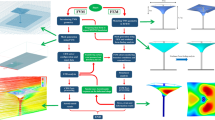Abstract
To investigate the suitability of computational fluid dynamics (CFD) with regard to windbreak aerodynamics, simulations are performed with a state-of-the-art numerical scheme (Fluent) and compared against experimental data for two- and three-dimensional disturbances, namely the case of a long straight porous shelter fence and the case of a shelter fence erected in a square about an enclosed plot. A thorough sensitivity study quantifies the impact of numerical choices on the simulation (e.g. grid-point density, domain size, turbulence closure), and leads to guidelines that should ensure objective simulation of windbreak flows. On a fine grid Fluent’s “realizable k–ε closure” gives results that are in qualitative accord with the observed mean winds.
Similar content being viewed by others
References
Bradley EF and Mulhearn PJ (1983). Development of velocity and shear stress distributions in the wake of a porous shelter fence. J Wind Eng Ind Aerodyn 15: 145–156
Launder BE (1989). Second-moment closure and its use in modeling turbulent industrial flows. Int J Numer Methods Fluids 9: 963–985
Launder BE and Spalding DB (1972). Lectures in mathematical models of turbulence. Academic Press, London, England, pp, 90–110
Lien FS and Leschziner MA (1994). Assessment of turbulent transport models including non-linear RNG eddy-viscosity formulation and second-moment closure. Comput Fluids, 23(8): 983–1004
Lien FS, Yee E and Wilson JD (2005). Numerical modelling of the turbulent flow developing within and over a 3-D building array, Part II: a mathematical foundation for a distributed drag force approach. Boundary-Layer Meteorol 114: 245–285
Packwood AR (2000). Flow through porous fences in thick boundary layers: comparisons between laboratory and numerical experiments. J Wind Eng Ind Aerodyn 88: 75–90
Patankar SV (1980) Numerical heat transfer and fluid flow. McGraw-Hill
Shih T-H, Liou WW, Shabbir A, Yang Z and Zhu J (1995). A new k-ε eddy-viscosity model for high Reynolds number turbulent flows–model development and validation. Comput Fluids, 24(3): 227–238
Speziale CG, Sarkar S and Gatski TB (1991). Modelling the pressure–strain correlation of turbulence: an invariant dynamical systems approach. J Fluid Mech 227: 245–272
Raithby GD and Doormaal JP (1984). Enhancements of the SIMPLE method for predicting incompressible fluid flows. Numer Heat Transfer 7: 147–163
Wang H, Takle ES (1995). A numerical simulation of boundary-layer flows near shelterbelt. Boundary-Layer Meteorol 75: 141–173
Wilson JD (1985). Numerical studies of flow through a windbreak. J Wind Eng Ind Aerodyn 21: 119–154
Wilson JD (2004). Oblique, stratified winds about a shelter fence I: measurements. J Appl Meteorol 43: 1149–1167
Wilson JD (2004). Oblique, stratified winds about a shelter fence II: comparison of measurements with numerical models. J Appl Meteorol 43: 1392–1409
Wilson JD and Flesch TK (2003). Wind measurements in a square plot enclosed by a shelter fence. Boundary-Layer Meteorol 109: 191–224
Wilson JD and Yee E (2003). Calculation of winds disturbed by an array of fences. Agric For Meteorol 115: 31–50
Yakhot V and Orszag SA (1986). Renormalization group analysis of turbulence: I. Basic theory. J Sci Comput 1(1): 1–51
Author information
Authors and Affiliations
Corresponding author
Rights and permissions
About this article
Cite this article
Bourdin, P., Wilson, J.D. Windbreak Aerodynamics: Is Computational Fluid Dynamics Reliable?. Boundary-Layer Meteorol 126, 181–208 (2008). https://doi.org/10.1007/s10546-007-9229-y
Received:
Accepted:
Published:
Issue Date:
DOI: https://doi.org/10.1007/s10546-007-9229-y




